人教版(2019)选修 第四册Unit 3 Sea Exploration Using Language(1)_ Listening and Speaking课件(共16张PPT)
文档属性
| 名称 | 人教版(2019)选修 第四册Unit 3 Sea Exploration Using Language(1)_ Listening and Speaking课件(共16张PPT) |  | |
| 格式 | pptx | ||
| 文件大小 | 24.1MB | ||
| 资源类型 | 教案 | ||
| 版本资源 | 人教版(2019) | ||
| 科目 | 英语 | ||
| 更新时间 | 2024-04-11 12:35:59 | ||
图片预览

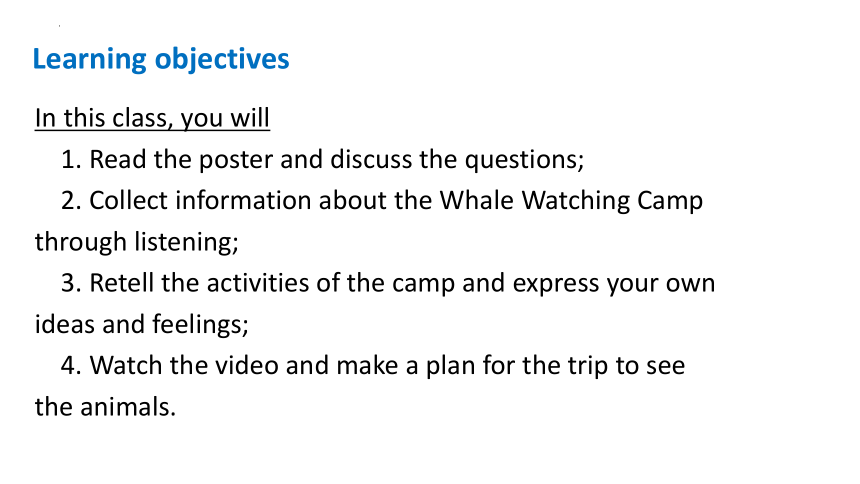
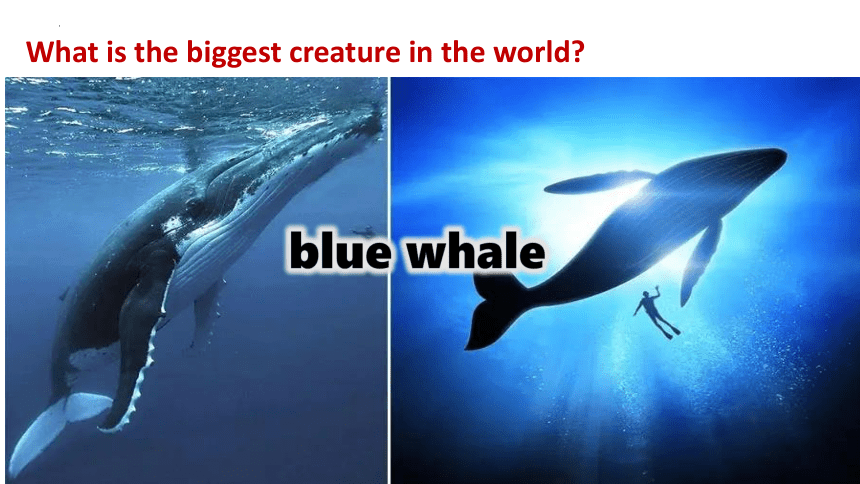
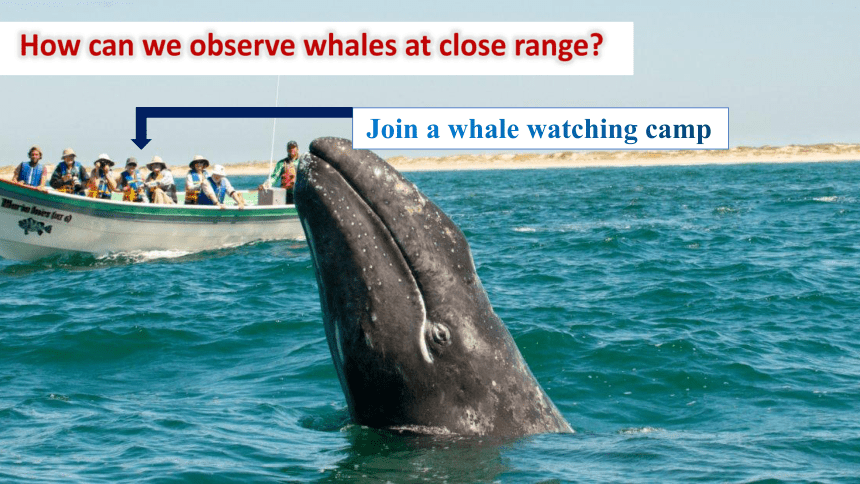
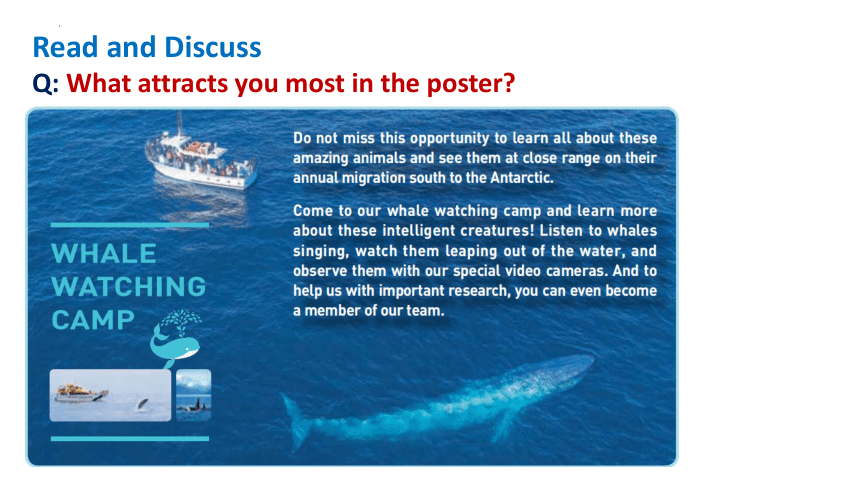

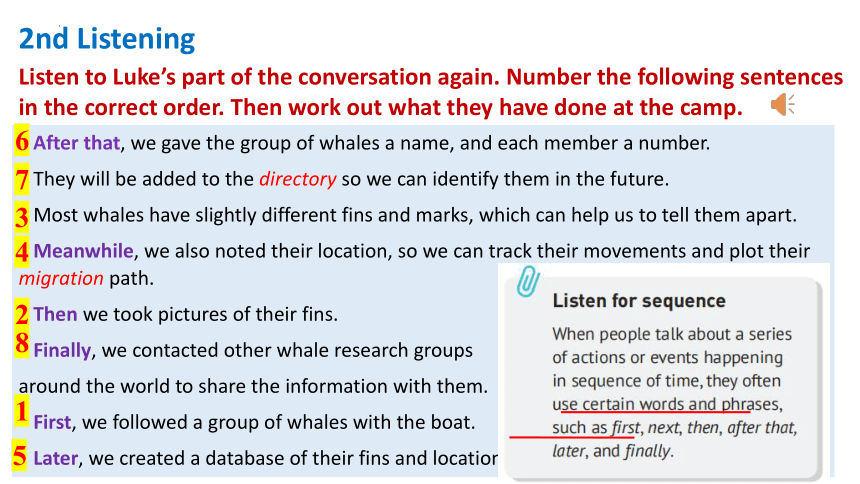
文档简介
(共16张PPT)
Unit 3 Using Language(1):
Listening and Speaking
年 级:高 三
学 科:高中英语(人教版 选必四)
Learning objectives
In this class, you will
1. Read the poster and discuss the questions;
2. Collect information about the Whale Watching Camp through listening;
3. Retell the activities of the camp and express your own ideas and feelings;
4. Watch the video and make a plan for the trip to see the animals.
blue whale
What is the biggest creature in the world
Join a whale watching camp
How can we observe whales at close range
Read and Discuss
Q: What attracts you most in the poster
1st Listening
Listen to the head researcher talking to the campers at the end of day. What three things were the campers asked to do
1. ___________________________________________________
2. ___________________________________________________
3. ___________________________________________________
to find out some facts for a whale profile
to think about why they do whale research
to go out with and write a report of the work they do
After that, we gave the group of whales a name, and each member a number.
They will be added to the directory so we can identify them in the future.
Most whales have slightly different fins and marks, which can help us to tell them apart.
Meanwhile, we also noted their location, so we can track their movements and plot their migration path.
Then we took pictures of their fins.
Finally, we contacted other whale research groups
around the world to share the information with them.
First, we followed a group of whales with the boat.
Later, we created a database of their fins and locations.
1
2
3
4
5
6
7
8
Listen to Luke’s part of the conversation again. Number the following sentences in the correct order. Then work out what they have done at the camp.
2nd Listening
Listen to the conversation again and answer the questions.
1. How many species of whales are there
2. What is the criterion to divide the main types of whales
3. What do whales use sounds for
4. Why do the campers take pictures of the whales' fins
5. Why do they contact other research groups
3rd Listening
1. How many species of whales are there
Over 80.
2. What is the criterion to divide the main types of whales
The criterion is whether they have teeth or not.
3. What do whales use sounds for
They use sounds to communicate and hunt.
4. Why do the campers take pictures of the whales' fins
This can help them to tell the whales apart.
5. Why do they contact other research groups
They want to share information with them.
3rd Listening
Some of the students could not make it to the camp. Imagine you were there. Tell your partner about what happened, using the expressions in the box below. Your partner can also ask questions to find out more about what happened.
Expressing sequence
First(ly),… Second(ly), ... Third(ly), ...
First of all... Then/After that/Afterwards/Next/Later on…
In the end/At last, ... At that time..
It began when... Meanwhile… Later… Finally…
Talk and Discuss
Q1: Which activity impressed you most And why
Q2: Is it important to carry out research on whales and other sea creatures
What other sea animals would you like to see
What would you like to know about these sea animals
Watch
What sea animals can you see in the video
Watch
What sea animals did you see?
jellyfish
seals
octopus
reef sharks
crabs
Talk with your partner and make a plan for a trip to see the animals. Your plan should include activities you would like to do.
Time
Place
Route 1 Activity Purpose of the activity
Route 2
Talk
For our trip, we would like to go to the Shanghai Ocean Aquarium, whose theme is “Spanning five continents by a connection of water”. We can first visit the special exhibition of saving sharks. Then we can go to see the seahorses whose number declined greatly for the past decade. However, most people do not know much about seahorses at all. I think we need to raise awareness about seahorses and marine conservation in China. The last spot will be The Chinese Pavilion, which displays the aquatic organisms and bio-system in the Yangtze River and some national endangered rare aquatic creatures, like Chinese alligator and Chinese Sturgeon.
Example
Assignment
1. Search more information, pictures or videos about sea animals.
2. Prepare a short speech about protecting biodiversity and present it to the class.
Unit 3 Using Language(1):
Listening and Speaking
年 级:高 三
学 科:高中英语(人教版 选必四)
Learning objectives
In this class, you will
1. Read the poster and discuss the questions;
2. Collect information about the Whale Watching Camp through listening;
3. Retell the activities of the camp and express your own ideas and feelings;
4. Watch the video and make a plan for the trip to see the animals.
blue whale
What is the biggest creature in the world
Join a whale watching camp
How can we observe whales at close range
Read and Discuss
Q: What attracts you most in the poster
1st Listening
Listen to the head researcher talking to the campers at the end of day. What three things were the campers asked to do
1. ___________________________________________________
2. ___________________________________________________
3. ___________________________________________________
to find out some facts for a whale profile
to think about why they do whale research
to go out with and write a report of the work they do
After that, we gave the group of whales a name, and each member a number.
They will be added to the directory so we can identify them in the future.
Most whales have slightly different fins and marks, which can help us to tell them apart.
Meanwhile, we also noted their location, so we can track their movements and plot their migration path.
Then we took pictures of their fins.
Finally, we contacted other whale research groups
around the world to share the information with them.
First, we followed a group of whales with the boat.
Later, we created a database of their fins and locations.
1
2
3
4
5
6
7
8
Listen to Luke’s part of the conversation again. Number the following sentences in the correct order. Then work out what they have done at the camp.
2nd Listening
Listen to the conversation again and answer the questions.
1. How many species of whales are there
2. What is the criterion to divide the main types of whales
3. What do whales use sounds for
4. Why do the campers take pictures of the whales' fins
5. Why do they contact other research groups
3rd Listening
1. How many species of whales are there
Over 80.
2. What is the criterion to divide the main types of whales
The criterion is whether they have teeth or not.
3. What do whales use sounds for
They use sounds to communicate and hunt.
4. Why do the campers take pictures of the whales' fins
This can help them to tell the whales apart.
5. Why do they contact other research groups
They want to share information with them.
3rd Listening
Some of the students could not make it to the camp. Imagine you were there. Tell your partner about what happened, using the expressions in the box below. Your partner can also ask questions to find out more about what happened.
Expressing sequence
First(ly),… Second(ly), ... Third(ly), ...
First of all... Then/After that/Afterwards/Next/Later on…
In the end/At last, ... At that time..
It began when... Meanwhile… Later… Finally…
Talk and Discuss
Q1: Which activity impressed you most And why
Q2: Is it important to carry out research on whales and other sea creatures
What other sea animals would you like to see
What would you like to know about these sea animals
Watch
What sea animals can you see in the video
Watch
What sea animals did you see?
jellyfish
seals
octopus
reef sharks
crabs
Talk with your partner and make a plan for a trip to see the animals. Your plan should include activities you would like to do.
Time
Place
Route 1 Activity Purpose of the activity
Route 2
Talk
For our trip, we would like to go to the Shanghai Ocean Aquarium, whose theme is “Spanning five continents by a connection of water”. We can first visit the special exhibition of saving sharks. Then we can go to see the seahorses whose number declined greatly for the past decade. However, most people do not know much about seahorses at all. I think we need to raise awareness about seahorses and marine conservation in China. The last spot will be The Chinese Pavilion, which displays the aquatic organisms and bio-system in the Yangtze River and some national endangered rare aquatic creatures, like Chinese alligator and Chinese Sturgeon.
Example
Assignment
1. Search more information, pictures or videos about sea animals.
2. Prepare a short speech about protecting biodiversity and present it to the class.
